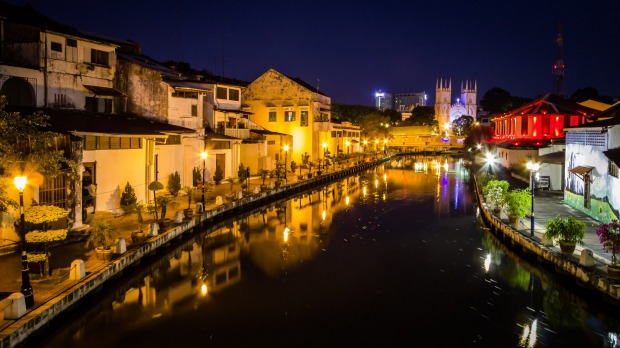
It's probably not surprising that in a city, and for that matter a country, where eating is more or less the national sport, that one of the signature treatments on the spa menu at the hotel where I'm staying should involve a foodstuff. And chosen for me is the traditional egg roll therapy. As I lie face down on the massage table, there is the disconcerting, though unmistakable, sound of boiling in the background. I can't be sure if I'm getting my eggs hard or runny and I have to trust that they won't make their way to my breakfast table tomorrow.
Surely not. I'm staying at the Majestic Malacca, the classiest place in town. At the end of the massage I ask to see the eggs. The Malaysian masseuse holds a rather lewd-looking pouch containing two round objects that moments ago were being rolled over my now admittedly relaxed body. Feeling good from the massage, it also feels good to be back in Malacca.
Since I was last here about three decades ago, this ancient Malaysian trading port has been on something of, dare I say, a roll itself. In 2008, it received a joint UNESCO World Heritage listing with Georgetown, located on the island, Penang, to the north of the country, in recognition of their unique architectural heritage. "The two towns constitute a unique architectural and cultural townscape," UNESCO stated in its inscription, "without parallel anywhere in east and south-east Asia".
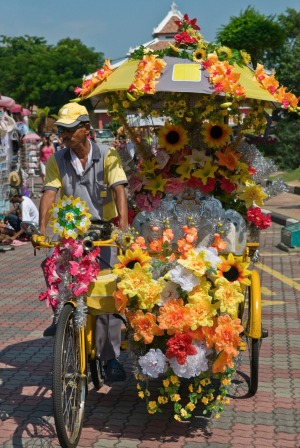
Both Georgetown and Malacca are so well preserved – more by accident than design – that they provide a palpable sense of what a place like Singapore would have resembled before progress led to the demolition of its distinctive shop-houses and other historic buildings. On my first visit to cosmopolitan Malacca, a place that's still not all that easy to get to, I came on a perilous coach ride from Singapore with the foreign passengers (me included) having to plead with the driver to desist from overtaking on hairpin corners. Malaysians at that time were rated among the world's worst drivers.
Nowadays it's freeway all the way from Singapore – notably via a surprisingly formidable and sizeable frontier that denotes the tetchy relations between the two south-east Asian nations. Today the driving is a lot more tolerable even though the coach captain on my bus from Singapore elects to drop me a few blocks from my hotel, forcing me to find my own way to it in the mad-dog, noon heat. Oh well, take a cab if you want door-to-door service.
Although Malaysia itself has changed irrevocably – the very model, with some serious political reservations, of a modern Islamic state – Malacca itself, thank goodness, has altered little – save, that is, for some worrisome, creeping high-rises near the edge of the World Heritage zone. There is even a superfluous monorail track that the local burghers have been unable to render operational since it was installed a few years ago.
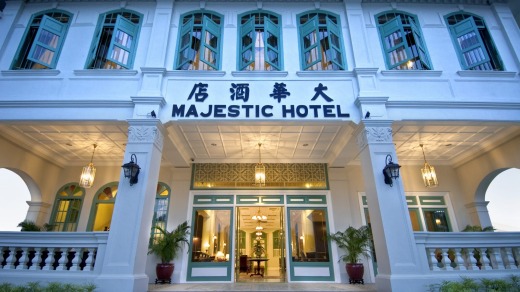
The Majestic Malacca was, until 2004, an abandoned shell. It's the nearest there is to a decent colonial-era-hotel in town and the best place to stay in Malacca, although its design is a neat sleight of hand. The building housing the reception, lobby, bar and restaurant is a charming old mansion, once the lavish residence of a rich Chinese businessman who eventually fell on hard times.
It's teamed with a relatively discreet and sympathetic, 10-storey high-rise built at the rear, with modern rooms doing a fine impression of being from the era of the much older building. Across the road from the hotel is an extraordinary sight: a former fishing village, including houses with tin red roofs, that was transferred from the seaside by the British.
Both Malacca and Georgetown have had more colonisers then they've had hot rendangs. Once one of the most important trading ports of the Far East, as the British still like to call it, Malacca's wealth and strategic location were prizes too tempting for a succession of imperialist nations. The city dates to the 15th century, having been founded by a Sumatran prince who chose to name the city after a local tree, with Malacca first falling to the Portuguese in the 16th century, then the Dutch in the 17th, the British in the 18th. I guess you also could count the short and brutal 20th-century rule of the Japanese during World War II.
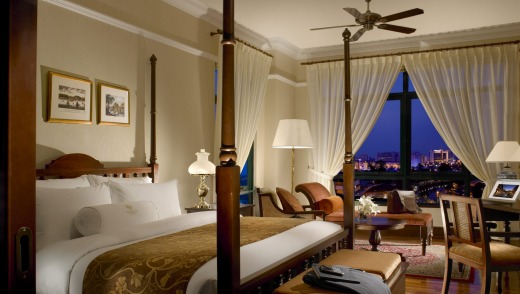
On the outskirts of town a small Portuguese community has survived with the language, or a dialect of it, still spoken by many descendants. But the city's most indelible influence comes from the Baba-Nyonyas, or Straits Chinese, descendants of the first Chinese merchants who married local Malay women, creating a unique culture, known as Peranakan.
Of course, the centrepiece of Malacca is its coveted World Heritage zone and one of the best ways to explore it is on a guided tour, with The Majestic offering a free historical walk. I take one the next morning with a small and eclectic group of fellow houseguests. We follow a riverside boardwalk – minding the missing timber slats here and there. Then our guide, Rahayu, a well versed Malaysian woman from Kuala Lumpur, pauses on a footbridge – one of the many that pass over the Malacca River that runs through the city and near the old Indonesian quarter.
It is here, she says, that the Japanese occupiers during World War II conducted their summary beheadings. The severed heads were tossed into the river. No wonder it's still known among locals as the "Ghost Bridge". Beyond the bridge, with my shirt starting to stick to my back like paparazzi to a Kardashian, we pass an atmospheric street where on either side ancient, darkly lit specialty shops, selling everything from knives to nails, are slowly dying out, one by one, being replaced by cafes and the like.
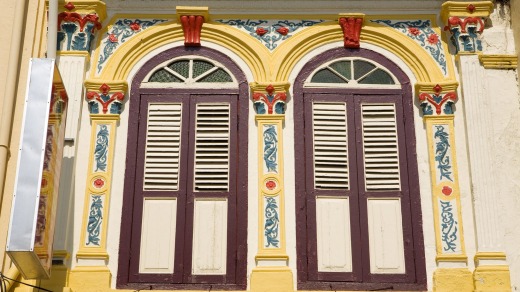
The streets are full of colourful, photogenic Baba Nyonya shophouses, with their mandatory shuttered windows while on Jalan Tukang Emas – also known as "Harmony Street" – an Islamic mosque and Hindu and Buddhist temples are neighbours. But it is the magnificent crimson-coloured 18th-century Dutch church – Malacca's own "Red Square", that draws the most tourists. It was the oldest building I'd ever seen when I first visited all those years ago. The Dutch built the church to commemorate the centenary of their colonial rule of Malacca in 1653. Eventually the British, having conquered the Dutch, transformed it into an Anglican church but, in looks alone, it will forever remain Dutch.
By the time the tour ends it's already lunchtime and with the heat intensifying, I take a trishaw back to the Majestic; the short journey complete with the obligatory attempt to entice me into a store to buy a watch. The driver is nearing 70 and still toiling in a job, it must be said, with some of stain of colonialism still attached to it. He is a reminder, too, that it's not just the buildings that provide a record of Malacca's past.
He tells me he has spent nearly 30 years plying the streets of Malacca on three wobbly wheels, laughingly referring to his trishaw, adorned in faded plastic flowers, as his "antique treasure". His dark, weathered skin affirms all those years spent outdoors. As I wander back into the Majestic, having tipped the driver handsomely after denying him a commission at the watch shop, it occurs to me that if anyone deserves a restorative egg roll therapy in this town it has to be this kindly, hard-boiled gentleman.
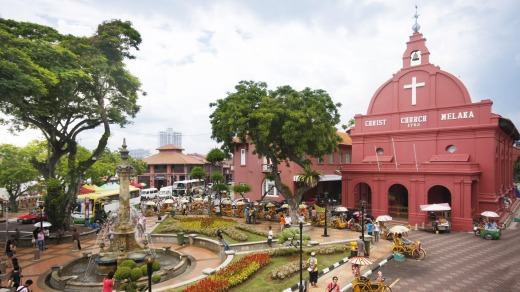
It's no Seine but a cruise on the Malacca River is popular for visitors, especially by night when the city's historic building are illuminated. See www.ppspm.gov.my
Also known by its Malay name, Jalan Hang Jebat, vibrant Jonker Street is Malacca's main tourist strip full of antique shops, restaurants and cafes. See tourism.gov.my
Built in 1650 as the colonial Dutch governor's residence, The Stadthuys is believed to be the oldest surviving Dutch building in south-east Asia. See www.perzim.gov.my
This private museum on Jalan Tun Tan Cheng Lock (Heeren Street) features artefacts unique to the Straits Chinese, or Baba Nyonya community. See www.babanyonyamuseum.com
Also known as a "mini Lisbon", the square is in the small Portuguese village where inhabitants can trace their ancestry 400 years to Portuguese colonial times. See tourism.gov.my
tourism.gov.my
Scoot flies daily from Sydney to Singapore. From November 1, the Singapore-based low-fare airline will fly five times a week from Melbourne to Singapore. See flyscoot.com.
From Singapore, the best way to get to Malacca is by coach. Various operators run multiple daily services to Malacca costing between $16 and $50 and taking between three and four hours. See easybook.com/bus-singapore-melaka. The equivalent trip between Kuala Lumpur and Malacca costs between $3.60 and $21 and takes about 2½ hours.
Doubles at the Majestic Malacca Hotel start from $127, 188 Jalan Bunga Raya, Malacca, Malaysia. Phone +60 3-2783 1000, see www.majesticmalacca.com